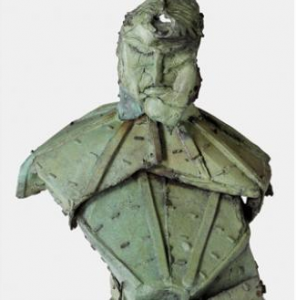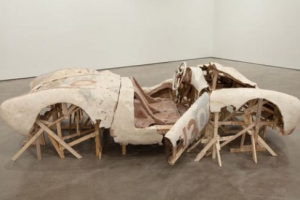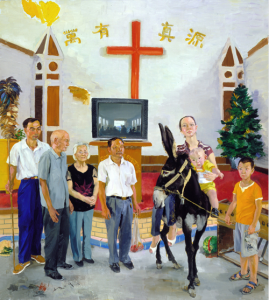The third of three blockbuster contemporary art survey shows to hit New York in the past year, Greater New York was worth waiting for. The New Museum’s youthfest, The Generational, showcased an under ripe generation still finding its voice. The Whitney Biennial presented artists self-consciously grappling with new ways to be ‘experimental.’ Despite the fact that these shows shared several artists, Greater New York swapped the previous ‘watch-this-space’ vibe for mature, confident work by 68 artists and collectives, evenly balanced between male and female, whose collective fostering of identity politics – sexual, racial, political and personal – broke with recent art world trends towards hermeticism and reconnected with the larger world.
If identity politics has come to sound retro in ‘post-black’ days, Hank Willis Thomas’ monumental photo series made it joltingly relevant, connecting yesterday to today by tracking the persistence of stereotype and recent fantasies of racial integration through forty years of magazine ads. Rashaad Newsome’s video of over twenty female performers uttering partial phrases like ‘excuuuuuse…’ or ‘giiirl’ is one of the best pieces at PS1 (though technically part of an auxiliary exhibition reviewing the last five years of artmaking), succinctly demonstrating how slang and role play create exclusive group identities.
Alternative sexuality was the norm in the third floor galleries, where Sharon Hayes’ five channel video installation ‘Revolutionary Love’ brilliantly integrated the concerns of participants inside and protesters outside the 2008 Democratic and Republican National Conventions before veering quixotically off topic by demanding love along with legal rights. But her assertion, ‘we’re all queer’ makes perfect sense in light of Leigh Ledare’s creepily incestuous photos of his exhibitionist mom, which prove that anyone, heterosexuals included, can pretty much chart their own course. LaToya Ruby Frazier’s photos of her own mother come to mind (from the New Museum Triennial); in her video contribution here, her tense, naked torso – juxtaposed with clouds of factory steam – pulsated with unspoken feeling.
Proving that identity politics don’t have to be dour, K8 Hardy’s fabulously eclectic self-portraits in outrageous getups place her characters outside recognizable ‘types.’ A similar inventive exuberance carries downstairs to A.L. Steiner’s photocollaged lesbian utopia where one nude joker embraces a reproduction of Courbet’s ‘Origins’ and another dangles her pendulous breasts over two globs of dough. Identity aside, other galleries exploded with color or formal inventiveness, including Kerstin Bratsch’s and Adele Roder’s abstract paintings, which distill distinctly a modernist appeal in terms of color and geometry, and Mariah Robertson’s audacious, show stopping 30” by 100’ photogram wrapped around gallery floor, walls, and ceiling.
Press material posited the ‘process of creation and the generative nature of the artist’s studio’ as the show’s dominant theme, though Robbinschild’s installation conveyed little when the artist’s weren’t present, Ei Arakawa gave out candy to studio visitors one day in apology for lack of a performance, and The Bruce High Quality Foundation’s program to swap new pedestals for used ones from art collages was a space-hogging one-liner. On the other hand, Naama Tsabar’s ‘Speaker Wall,’ two walls of bookshelf speakers rigged with strings into irresistible collaborative instruments, generated the hive of activity that the curators must have hoped for.
Tsabar’s invitation to engage in her work was literal, but for the most part, Greater New York’s best pieces stood out for their complex engagement with issues outside the art world (gay rights, racial, class and gender politics, etc). A couch featuring news clippings of President Obama and photos of a disfigured young Marine were among the most memorable images of the Whitney Biennial; likewise, pieces like David Brook’s living trees encased in concrete – a protest of deforestation in the Amazon, amongst other things – made the connection to an existing conversation amongst a wider audience, making this show the one we’ll likely continue to talk about.
Originally published in Flash Art International, no 274, October 2010.



